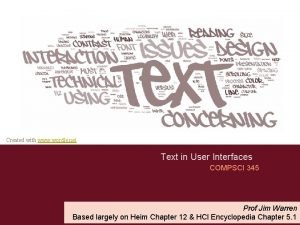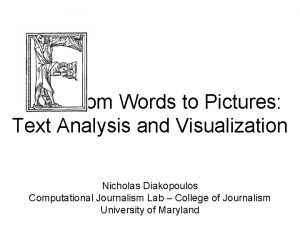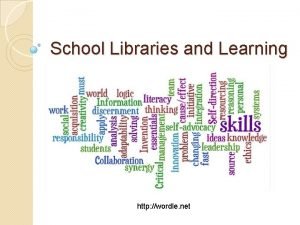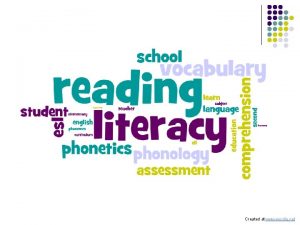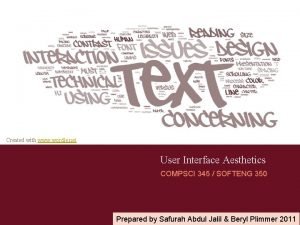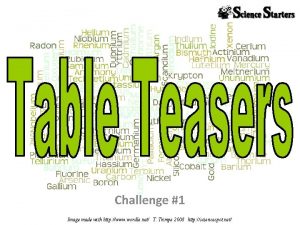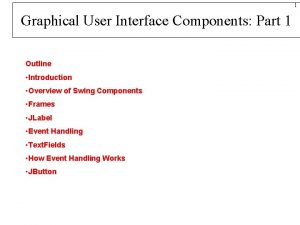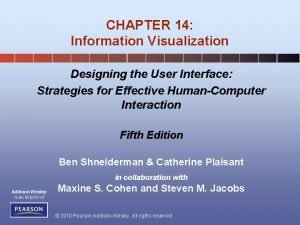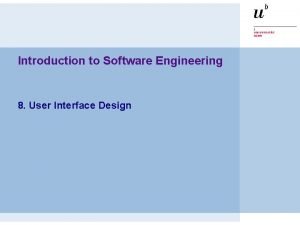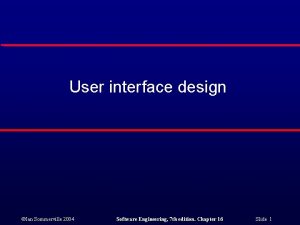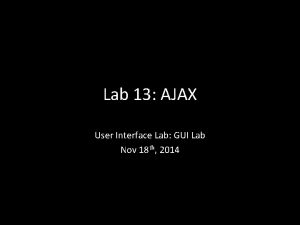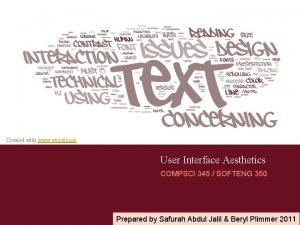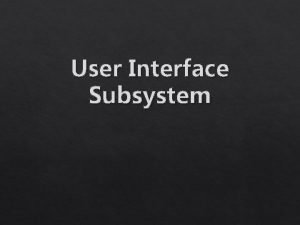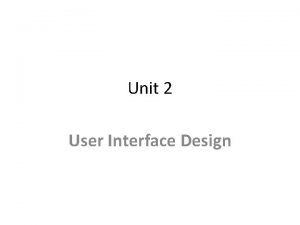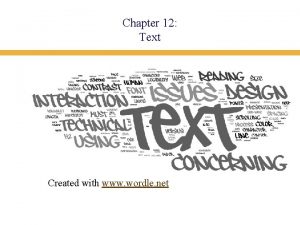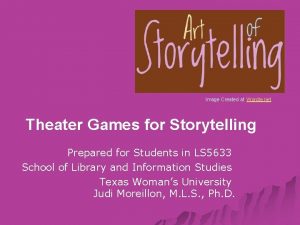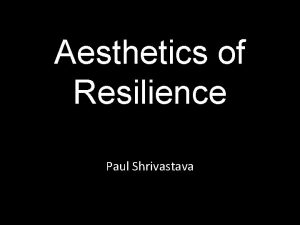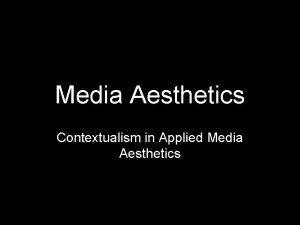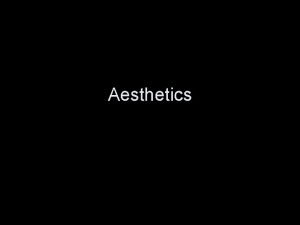Created with www wordle net User Interface Aesthetics



















- Slides: 19

Created with www. wordle. net User Interface Aesthetics COMPSCI 345 / SOFTENG 350 Prepared by Safurah Abdul Jalil & Beryl Plimmer 2011

Human Issues n The Reading Purpose n Continuous process (reading a novel) n Scanning n Reading interface - screen or paper n Paper is more flexible than electronic media n We often rely on our spatial memory when we search for information Place holders

3 Human Issues n Active reading aids comprehension n Using your pen to follow lines Annotating the text I have done quite a lot of annotation research. Have a look here http: //www. cs. auckland. ac. nz/research/hci/digital_ink/annotation_tools/index. shtml

Text in Interaction Design n Commentary/Instrumental n Commentary text is text that informs. n Instrumental text is text that works; e. g. hyperlinks, button labels (this will be covered in the lecture on forms & controls) n Legibility n Can the reader discern the words n Readability n Can the reader easily read the text n Physical n Factors What is the screen resolution, brightness

5 Remember the reading process? n We read lowercase more quickly than UPPERCASE n Lowercase presentation is more common n Except when people don’t want you to read it Do they want you to read the chocolate bar wrapper?

6 Typography craft and an art n Art Book of Kells (6 th century) n Craft n n n Arranging glyphs (letters) Dates from earliest printing presses Its history is evident in the terms we use n Leading

+ 7 Basic Anatomy of letterforms Image modified from http: //26. media. tumblr. com/tumblr_kx 1 onh. Pp. D 61 qajttoo 1_500. gif

8 Fonts: serif & sans serif http: //www. pixel 77. com/typography-type-and-typefaces/ ‘Sans’ is “without”, therefore sans serif fonts are fonts without serifs n People still argue whether serif (Times New Roman) or san serif (Arial) is easier to read on a screen n Small serif fonts are less legibility on low res screens n Georgia, Verdana, and Trebuchet maintain legibility at small sizes and have been designed to facilitate reading on the Web

+ 9 Fonts for title vs. body Decorative/Display fonts n Decorative fonts (sometimes called display fonts or title fonts) n n n suitable for titles and headings strong personality: n grab people’s attention n reinforce the message of the word. May not be installed on all machines – in which case you need to have a default! n Neutral looking fonts such Times or Arial are more suitable as body copy (easier to read)

+ 10 Fonts for title vs. body

11 Fonts: proportional & monospaced http: //library. kiwix. org: 4201/A/Typeface. html n A proportional font has variable-width: ioioio n A monospaced font has fixed-width ioioio n Example of courier page

Font Size n Factors that affect perceived font size: n Reading Distance—Greater distances require larger text. n Screen Resolution—Smaller text requires greater resolution to keep the characters clear and legible. n Text/Background Contrast—Positive contrast is optimal (black type on a white background). n Visual Acuity of User—Not all users have 20/20 vision. n Purpose —Text can be scanned, read word by word, or read character by character

13 Font Size n Fonts for body copy usually don't work well when set too large, they tend to become inelegant and clunky. Example n The opposite is the case when setting titling fonts too small – the title/heading will lose its dominance and the page looks bland. Example

14 Font Size n Fonts of the same size, say 11 pt, will sometimes look different in size due to their different x-heights. http: //www. pixel 77. com/typography-type-and-typefaces/ n These fonts are all in the same size (36 pt): aaaa Looks bigger Looks smaller n Example 1 & (Times New Roman & - example 2 looks slightly smaller) example 2 Book Antiqua

Weight & Style n Weight n Bold When two fonts differ in weight, they form a strong and vibrant visual contrast. e. g. between heading and body copy n Style n n Italics - example Underline n Underlines will be mistaken as a hyperlink n so don’t use except for links n Besides emphasizing points, creating contrast by varying weight and style can contribute to a dramatic and eye-catching look to an interface. It guarantees that your page will not look dull. n However, use with restraint and be consistent. n too many weight and styles on one screen gets confusing.

Spacing & Alignment Vertical line spacing n n The spacing between lines of text (single spacing, double spacing, etc. ) is called leading Increasing spacing improves reading speed n n n But takes more screen space Different languages need different amounts of leading n Korean needs lots more because letters are stacked Examples: without | with | too much Alignment n n n Use left or justified Right and centre are harder to read because can’t easily find beginning of the line Examples: left | justified | centre

Spacing & Alignment Line length n n Line length affects reading performance but not comprehension Lines of greater length are read more quickly n n n Up to a limit People prefer medium line lengths Examples: too short | medium | too long Margin width n n n Shorter lines— 4 inches—with large margins increased reading performance Maximal use of white space Examples: too little | medium | too much

18 To Summarize n Font n n n Size n n Italics and underline (links only) bring focus Spacing n n Bold emphasise and increases dominance Style n n Bigger is dominant and easier to read – but takes more screen real estate Weight n n Serif, san serif Proportional, mono space Increased leading makes it easier to read – but takes more screen real estate Alignment n n Left or justified is easiest to read. Small margins make it easier to read.

19 References n Tidwell, J. (2010) Designing Interfaces, Second Edition: Patterns for Effective Interaction Design. O'Reilly Media. Prepared by Safurah Abdul Jalil & Beryl Plimmer 2011
 Wordle net
Wordle net Www.wordle
Www.wordle Http://www.wordle.net/create
Http://www.wordle.net/create Http://wordle.net
Http://wordle.net Www.wordle
Www.wordle Wordle double letters
Wordle double letters Wordle.net
Wordle.net Http://www.wordle.net/
Http://www.wordle.net/ Wordle.net
Wordle.net Abowd and beale framework example
Abowd and beale framework example Industrial interfaces
Industrial interfaces Interface------------ an interface *
Interface------------ an interface * Interface in interface java
Interface in interface java Components of graphical user interface
Components of graphical user interface Graphical user interface design principles
Graphical user interface design principles Visualization in user interface design
Visualization in user interface design Principle of input design
Principle of input design User interface design in software engineering
User interface design in software engineering User interface design process in software engineering
User interface design process in software engineering Lab ajax
Lab ajax

